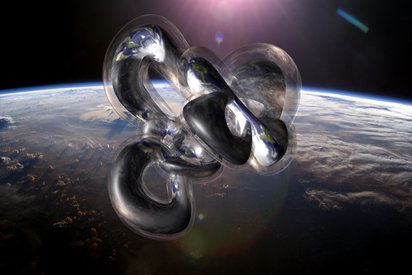Exploring Outer Space Through Architecture
The Canadian Centre for Architecture’s “Other Space Odysseys” boldly goes where few architects have gone before.
Outer space is the landscape of modern-day myth: take, for example, the godlike status of Neil Armstrong and the cultural indestructibility of Star Wars and Star Trek. Judging from Barack Obama's space plan, we want human beings in space and we want them there soon. With an unstable economy and impending environmental doom—the icing on the cake—the best option might just be the colonization of space.
Yet Alessandro Poli, an Italian architect, claims that it was precisely Apollo 11 that brought us back down to Earth. “It was space that conquered the Earth,” says Poli, “restoring the fascination of its true dimension rather than limiting the imagination.” From their “capsule,” Neil Armstrong, “Buzz” Aldrin and Michael Collins saw the Earth as “a fragile little object” instead of being “immense, unique, and laden with infinitely recyclable energy sources.”

Greg Lynn's "New City," a concept model for a new world
Likewise, acclaimed American architect Michael Maltzan suggests that “the ecological movement started with the moon flights. It wasn't until people were able to see the earth as a more finite idea that they turned their vision back to the Earth.” After seeing the Earth from outer space, Earthlings realized the limits, beauty and fragility of their home planet.
Both Poli's and Maltzan's work is being shown at “Other Space Odysseys,” an exhibition at the Canadian Centre for Architecture (CCA) in Montreal, along with the works of American architect Greg Lynn. The exhibition is a triptych celebrating architecture as the production of ideas rather than the manufacture of material goods. “Other Space Odysseys” seeks to avoid the typical domination-of-space-with-expensive-technology narrative, aiming instead to rethink architecture, space and our relationship with the Earth. The premise of the exhibition is the 1969 moon landing.
Architecture is generally considered bound by the land it sits on. But what about architecture without a landscape, without foundations, without constant gravity? How do we work with something so alien, uncompromising, and empty, and how do our forays into outer space make us reconsider the planet we live on?
The three architects answer these questions in different ways. Poli's exhibition includes the enthralling film Architettura interplanetaria (1972), which consists of cut-and-paste visuals that fantasize, among other things, about a highway from the earth to the moon. The material used is from newspaper articles and television broadcasts—the present and future are often cut-up versions of each other. The exhibition also includes studies of a make-believe meeting between Zeno, a Tuscan peasant who had never lived elsewhere but his shed in the Italian countryside, and Aldrin. Zeno and Aldrin both lived in self-enclosed “capsules,” but the difference, according to Poli, is “that Zeno built this ‘spaceship’ with his own hands and could ‘fly’ it by himself and produce the energy needed for the voyage.” Zeno was self-sufficient and responded to his environment with creativity, while Aldrin was completely governed by the scientists and the technology that shot him into space in the first place.
Maltzan presents a design for the Jet Propulsion Laboratory in California that tried to change the space in which the scientists worked with regards to the (outer) space were trying to explore. Maltzan remarks that “even though the JPL building is completely land-based—my project is about the space of the mind.” Whenever the scientists are monitoring satellites traversing the solar system, they're still bound by the architecture of the building, so Maltzan attempted to create a structure that offers different opportunities.
Finally, part of Greg Lynn's work is an imagination of a “New City”—what he calls ”the first architecturally considered virtual world.” Since our understanding of the world changes—once flat, now round—Lynn imagined a world that isn’t confined to any shape. It changes and moulds into alien and unrecognisable forms. “What you would see if you went to New City,” says Lynn, “is based on what you want to see. It's a series of lenses of information that you can overlay onto the space.” What’s impressive about Lynn’s work is how he tries to steer away from strict definitions. His future is otherworldly—how could we even understand anything constructed in outer space?
While well thought-out, the exhibition suffers from an information overload. At one point, Maltzan tells the visitor what he wants you to see, what he wants you to walk away with. This is a no-no; art should inspire ideas, instead of closing off further interpretations.
In addition, I was a little disappointed by some of the media the architects chose to work with. Maltzan's exhibition includes Inkjet-printed photographs, and many of Greg Lynn's renderings are messy (and ugly) computer animations. The video animation of “New World” looks like a badly-produced Rogers commercial. Otherwise, though, the pieces are original conversations on the limits of outer space—this is space exploration as visually-stunning artwork.
“Other Space Odysseys” runs until September 19, 2010 at the Canadian Centre for Architecture.
Related on maisonneuve.org:
—Drawn & Quartered
—Run For Your Lives!
—Italy's Moon Landings
Subscribe to Maisonneuve — Follow Maisy on Twitter — Like Maisy on Facebook





